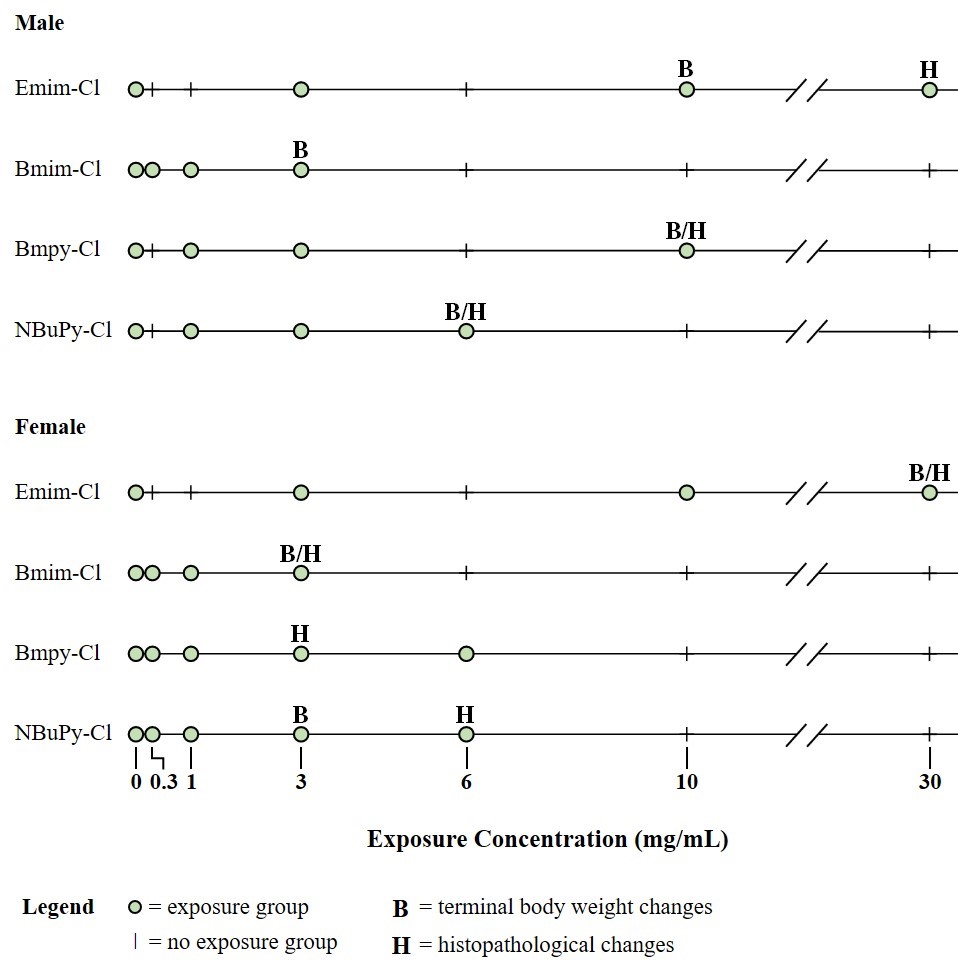Ionic liquids (ILs) are synthetic solvents with applications in a variety of industrial and chemical industries. Human exposure to this diverse chemical class is primarily through dermal or oral routes. Research suggests toxicity may be associated with IL structural characteristics, including the type of cation base or alkyl chain substitutions associated with the cation. To further investigate this hypothesis, the National Toxicology Program (NTP) conducted 3-month toxicity studies in male and female Sprague Dawley (Hsd:Sprague Dawley SD) rats and B6C3F1/N mice (n = 10/sex/exposure group; 3 exposure concentrations per IL) to compare the relative toxicities of four ILs administered via drinking water—1-ethyl-3-methylimidazolium chloride (Emim-Cl),1-butyl-3-methylimidazolium chloride (Bmim-Cl), 1-butyl-1-methylpyrrolidinium chloride (Bmpy-Cl), and n-butylpyridinium chloride (NBuPy-Cl).
To select exposure concentrations for the 3-month studies, 2-week drinking water studies in rats and mice were conducted to assess palatability and toxicity of each IL. Informed by the literature and preliminary palatability studies, exposure concentrations in the 2-week studies ranged from 0 to 100 mg/mL. Clinical observations (e.g., thinness and ruffled fur), lower water consumption, and lower mean body weights were associated with higher IL exposure concentrations. At the end of the 2-week exposure period, a range of organ weight changes and histological lesions was observed in rats and mice exposed to ILs. These observations were considered secondary to body weight changes and/or stress, rather than a direct toxic effect from 2-week IL exposure.
Exposure concentrations (ranging from 0 to 30 mg/mL) were selected for the 3-month studies because of the observed relative decreases in mean body weight (≤10%) and water consumption (<25%) in the 2-week studies. Rats were exposed to lower concentrations than mice for Emim‑Cl, Bmim-Cl, and NBuPy-Cl. Bmpy-Cl exposure concentrations differed by sex and species. Like the 2-week studies, a general pattern of lower water consumption at higher IL exposure concentrations was observed among rats and mice. Estimated average IL compound consumption indicated that mice consumed more IL per unit of body weight than rats at comparable drinking water concentrations for all ILs.
Rats exposed to Emim-Cl and Bmim-Cl for 3 months had similar terminal mean body weights compared to the control group at all exposure concentrations. Rats exposed to Bmpy-Cl and NBuPy-Cl, however, had significantly decreased terminal mean body weights at high exposure concentrations. Mice exposed to all ILs had significantly decreased terminal mean body weights, and male mice typically showed greater body weight differences than female mice at comparable concentrations. Several organ weight changes occurred in male and female mice, but most of these changes were considered secondary effects of decreased body weight and/or water consumption.
Rats exposed to ILs did not display an increase in histological changes; however, mice exposed to ILs displayed a significant increase in the incidences of nonneoplastic kidney and adrenal gland lesions. Incidences of chronic progressive nephropathy were significantly increased in male mice at the highest exposure concentrations of Emim-Cl and NBuPy-Cl. A positive trend for this lesion was observed in male mice exposed to Emim-Cl, Bmim-Cl, and NBuPy-Cl, as well as in female mice exposed to Bmim-Cl and NBuPy-Cl. Additionally, significantly increased incidences of renal tubule cytoplasmic alteration occurred in male mice exposed to the highest concentrations of Emim-Cl, Bmpy-Cl, or NBuPy-Cl. In female mice, the incidences of a persistent X-zone in the adrenal cortex were significantly increased for all four ILs at the highest exposure concentrations.
Additional data collected from this study suggest IL exposure has minimal effects on hematological or clinical chemistry parameters, does not influence overall survival or the female reproductive cycle, and is generally not genotoxic.
Overall, the results from this comparative study suggest that Emim-Cl, Bmim-Cl, Bmpy-Cl, and NBuPy-Cl in drinking water have minimal effects on rats and mice at low exposure concentrations (<3 mg/mL). Exposure to higher IL concentrations (≥3 mg/mL) results in lower body weights and nonneoplastic lesions in the kidneys of male and female mice and in the adrenal glands of female mice. The lowest-observed-effect levels (LOELs) were determined using these data. The LOELs were assigned as 10 mg/mL for Emim-Cl-exposed male mice, 3 mg/mL for Bmim-Cl-exposed male mice, 10 mg/mL for Bmpy-Cl-exposed male mice, and 6 mg/mL for NBuPy-Cl-exposed male mice. The LOELs for female mice differed slightly. The LOELs were 30 mg/mL for Emim-Cl-exposed female mice, 3 mg/mL for Bmim-Cl-exposed female mice (the same as for Bmim-Cl-exposed male mice), 3 mg/mL for Bmpy-Cl-exposed female mice, and 3 mg/mL for NBuPy-Cl-exposed female mice. These studies indicate that IL-induced toxicity may be attributable to alkyl chain length and cation type. ILs with longer alkyl chains typically exhibit increased toxicity compared to ILs with shorter alkyl chains. In this report, mice exposed to Bmim-Cl (an IL with a 4-carbon alkyl chain) had a lower LOEL than did mice exposed to Emim-Cl (an IL with a 2-carbon alkyl chain). The difference in toxicity among cations (imidiazolium vs. pyrrolidinium vs. pyridinium), however, is less clear and is both sex- and endpoint-dependent.
National Toxicology Program (NTP). 2022. NTP technical report on the toxicity studies of select ionic liquids (1-ethyl-3-methylimidazolium chloride, 1-butyl-3-methylimidazolium chloride, 1-butyl-1-methylpyrrolidinium chloride, and n-butylpyridinium chloride) administered in drinking water to Sprague Dawley (Hsd:Sprague Dawley SD) rats and B6C3F1/N mice. Research Triangle Park, NC: National Toxicology Program. Toxicity Report 103. https://doi.org/10.22427/NTP-TOX-103


